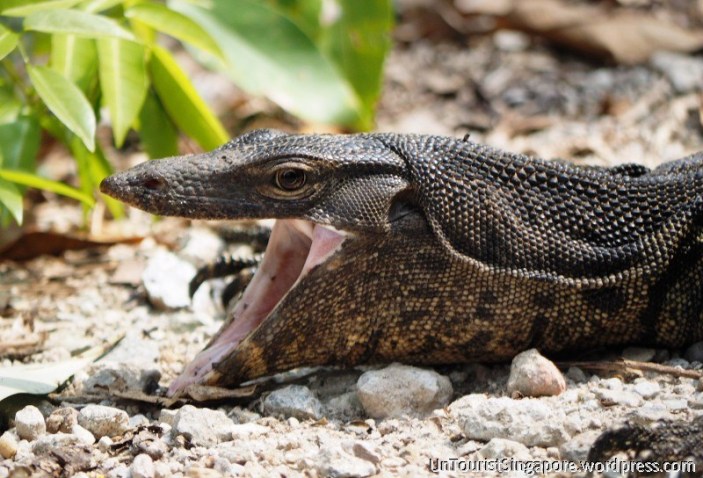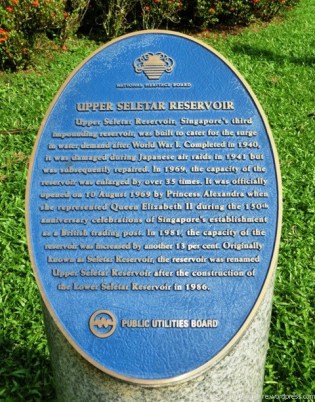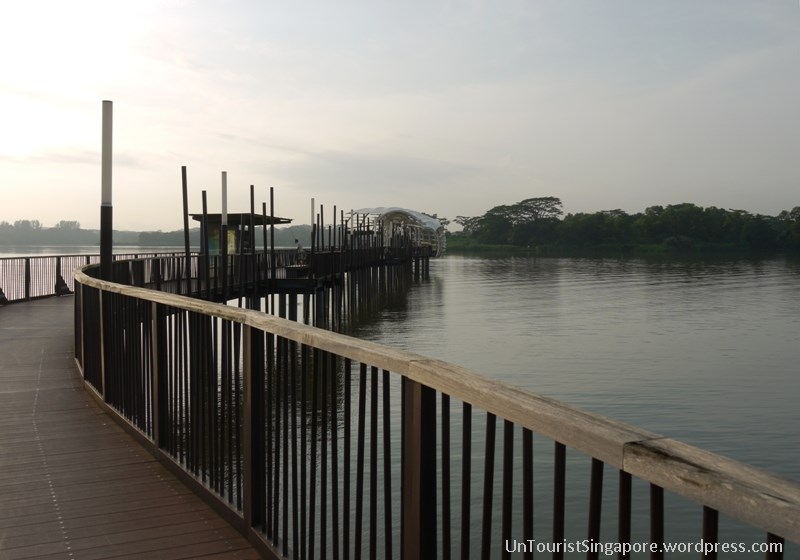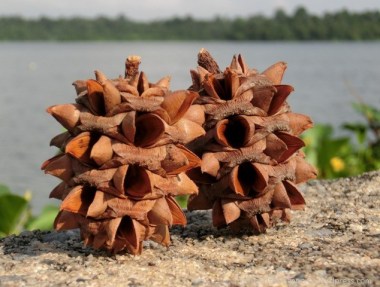Although the main attraction of the acclaimed wetland reserve is its birds – more than 260 local and migratory bird species have been recorded at Sungei Buloh, of late it is another type of wildlife that has been stealing the limelight at the reserve.
 Ever since a newspaper reported in December 2013 that a group of young schoolchildren on a field trip came within 20m of a 3m long crocodile across a footpath, other visitors have been visiting the reserve in search of crocodiles too.
Ever since a newspaper reported in December 2013 that a group of young schoolchildren on a field trip came within 20m of a 3m long crocodile across a footpath, other visitors have been visiting the reserve in search of crocodiles too.
On a trip to the wetland reserve just last month, I too secretly hoped to be able to spot a croc. As luck would have it, my friend and I saw not one but 2 of these magnificent creatures, and thankfully both were in the water at a more than safe distance away.
THE LOWDOWN
The coastal areas of Singapore were largely swamp land in the 1800s, with mangroves especially abundant in the north and west coasts. As Singapore developed rapidly over the years however the island became increasingly urbanized, and much of the coastal areas were redeveloped.
In 1986 a group of nature-loving bird enthusiasts realised the importance of the swamp area around the Sungei Buloh river as a migratory bird stopping ground, and petitioned the government to protect the site, which had been zoned as an agro-technology park. The government surprisingly acquiesced, and the Sungei Buloh Nature Park was created in 1989 as a bird sanctuary and nature haven. The park was officially opened in December 1993.
 In 2001 the park was accorded nature reserve status, and with an enlarged area was renamed the Sungei Buloh Wetland Reserve in 2002. The reserve went on to become Singapore’s first ASEAN (Association for South East Asian Nations) Heritage Park in 2003, and is now one of thirty-three parks in the region recognised as an important nature conservation site (Bukit Timah Nature Reserve is Singapore’s other contribution to the ASEAN Heritage Park list). The Sungei Buloh reserve is also one of only two conserved mangrove swamps in Singapore today, with the much smaller Pasir Ris Mangrove Swamp being the other.
In 2001 the park was accorded nature reserve status, and with an enlarged area was renamed the Sungei Buloh Wetland Reserve in 2002. The reserve went on to become Singapore’s first ASEAN (Association for South East Asian Nations) Heritage Park in 2003, and is now one of thirty-three parks in the region recognised as an important nature conservation site (Bukit Timah Nature Reserve is Singapore’s other contribution to the ASEAN Heritage Park list). The Sungei Buloh reserve is also one of only two conserved mangrove swamps in Singapore today, with the much smaller Pasir Ris Mangrove Swamp being the other.
The 130 hectare reserve in the far north-west is a rare piece of wild Singapore preserved. Bursting with flora indigenous to the wetlands in the region (approximately 250 native and naturalized mangrove species have been recorded), the reserve is also replete with wildlife.
Most importantly and prominently are the birds, for which the wetlands were primarily conserved for. The reserve’s annual bird census has recorded up to 5000 birds in a month at the reserve, although in recent years the numbers have declined significantly. Birds on the East Asian-Australasian flyaway use the mangroves as an important refuelling stop, on their travels from Australia all the way up north to Russia. At low tides the mudflats teem with life, from shellfish, worms and snakes, to mud-skippers, crabs and mud-lobsters, much of it rich pickings for the weary birds.
On land all manner of insects, as well as squirrels and monitor lizards roam freely, while the occasional wild boar and even otters have been spotted in the reserve.
The recent star however has been the estuarine or saltwater crocodile. These seemingly menacing reptiles have added a dash of dangerous excitement to the reserve for visitors. Although crocodiles have long been reported at the reserve, the numbers that have taken up residence in the reserve have risen from 2 in 2008 to about 10-12 today, heightening interest in the wetland reserve’s newest “attraction”.
I visited the reserve early in the morning (8 am) when there was hardly anyone around, and the air was cool and pleasant for a walk in the reserve’s secondary forest. Plenty of birds were already up and about and were singing up a storm, creating quite the din. The tide was out though so the landscape was just brown and muddy, not altogether attractive.
The entire trail throughout the reserve is about 7km long, however you can choose to do shorter sections of the trail. We covered most of the park trails, however some of it frankly wasn’t very interesting. There is a prawn pond at the far end of the trail for instance as the area had once been used for prawn farming, however this turned out really to be just another murky pond.
There are viewing hideouts around the trail for you to sit quietly and observe the birds and other wildlife, as well as an 18 metre high lookout tower called the Aerie in the centre of the reserve. Not having any birdwatching equipment, we found it hard to spot many interesting birds with the naked eye. We did catch a glimpse of what might have been an Osprey or Grey Eagle perched high on a branch in the distance though, thanks to a birdwatcher’s telescope.
About the crocodile sightings, as soon as we entered the reserve we spotted a submerged croc off the main bridge in the shallow water, although this one appeared to have had its tail nipped. Some 3 hours later as we crossed the main bridge again to leave, this time when the tide had come in, we saw a bunch of school kids excitedly pointing to something in the water and realised it was another croc floating among the mangroves. There was also a photographer with some serious equipment training his lens on the croc, which didn’t seem to be moving at all however. Here’s a pic of a less restful croc taken at the reserves recently though.
Be sure not to mistake the Malayan Water Monitor for a croc though. The reserve is full of these monitor lizards, known to grow to as large as 2 metres long. When the sun came out and it got warmer towards late morning, more of these cold-blooded reptiles crawled out to soak up the warmth from the sun. As you walk along the trails you’ll probably encounter a few monitor lizards along the path, and if you hear rustling in the bushes there’s a high chance it will be one of these giant pre-historic looking lizards. Beware these carnivorous creatures, they swallow their prey whole!
The wetland reserve is undergoing a transformation at the moment, so construction works are taking place and some areas were closed (the theatrette, and parts of the boardwalk trail). According to the Sungei Buloh Masterplan unveiled in 2008, the authorities are upgrading the wetland reserve to make it much more than just a nature park. Instead it aims for the reserve to be a premier wetland hub, with a state-of-the-art education and research facility. There were plans mooted to include guest accommodation even, for students and researchers to conduct studies in the reserve.
The wetland reserve will be much larger, and will include the newly upgraded Kranji trail on the east side, and the Lim Chu Kang coastal area on the west side. In the news recently in fact was the announcement that 5 developers have expressed interest in the project to develop the historic Cashin house on the pier to be linked to the Sungei Buloh trails.
According to the masterplan, the current Sungei Buloh reserve will be considered a core conservation area with reduced access by the public to protect the sensitive ecosystem, while the new Kranji area will be earmarked as the recreational area. The intent of the overall plan seems to be to do much more with the wetland reserve, after all ecotourism is all the rage now – and there is money to be made from this. The new bigger and better phase one enhancements of the wetland reserve is scheduled to open in the last quarter of 2014.
Do visit the wetland reserve now while entrance is free. Once the upgrades are completed an entrance fee will be charged. Singapore’s Night Safari, our popular nocturnal zoo which sees 1.1 million visitors annually, charges about US$30 per adult entrance ticket. Do the math and you’ll understand why the Singapore Government is shelling out big bucks to enhance the reserve and turn it into a major attraction.
LOCATION
301 Neo Tiew Crescent
This is a remote road in a remote corner of Singapore, deep in the heart of Singapore’s farm area.
Open:
7.30am to 7.00pm – Monday to Saturday
7.00am to 7.00pm – Sundays & Public Holidays
HOW MUCH TIME
About 3 – 4 hours to walk to the end of the park and back, at a pretty leisurely pace.
TAKE NOTE
- There are no toilets along the trail, so be sure to visit the loo at the main visitor centre before you set off. The trail map provided did indicate a toilet along the trail however we could not locate it, possibly because of the current construction and redevelopment works at the reserve.
- The lone cafe is currently closed so bring your own refreshments. There is a vending machine and a water fountain in the visitor centre though.
- Mosquito repellent – absolutely necessary.
- There are free guided tours organised every Saturday at 9.30am, as well as pre-booked guided tours available for S$6. The tours are fairly short though (1 hour), so you might want to just explore the reserve on your own.
- Singapore is ranked 6th out of 100 countries for mangrove diversity. Our mangrove forests contain half of the world’s recognised native mangrove species.
- Monitor lizards are considered a delicacy in some cultures. The Filipinos eat it fried (tastes like fried chicken), the Indonesians make it into a curry, and I’ve read that Foochows and other Chinese traditionally drink monitor lizard soup to improve their skin. Yums.
USEFUL LINKS
- Sungei Buloh Wetland Reserve site
- Link to brochure and trail map on the reserve’s site
- NPARKS (National Parks Board) downloadable walking guide to Sungei Buloh Wetland Reserve
- NPARKS site on Sungei Buloh animal videos with live streaming “animal cam”
- Map and listing of ASEAN Heritage Parks
- WildSingapore: Mangroves
* Thanks to Miin and her new Micro Four Thirds (MFT) camera for some of these awesome pics!






































